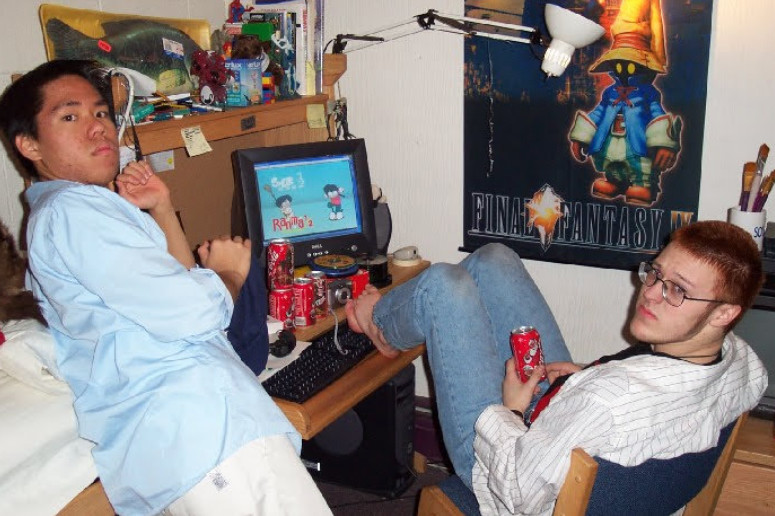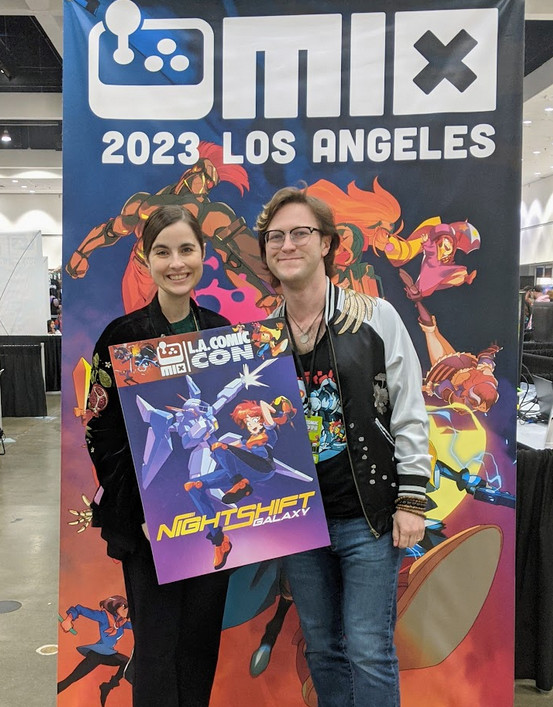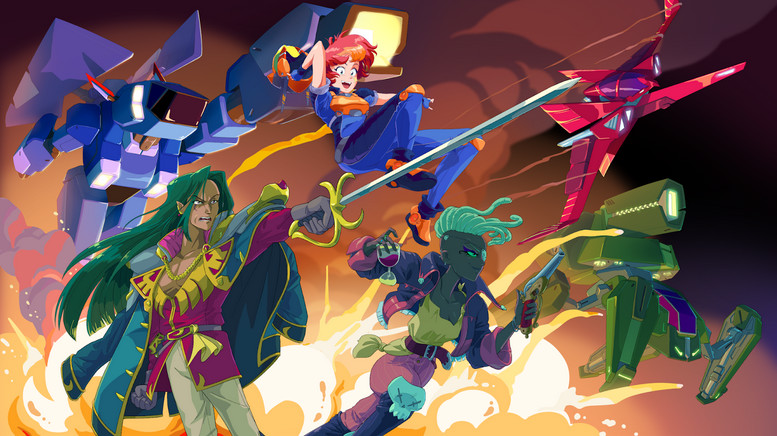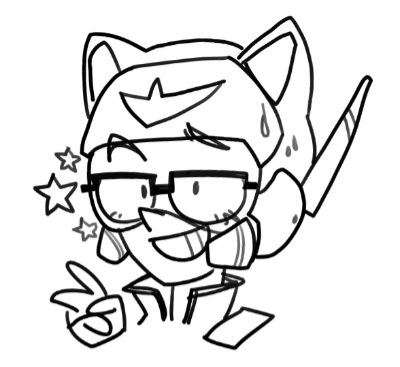Indie Game Pitching in 2024
I can’t believe how long it’s been since I wrote for the blog! My time has been fully-committed to an ambitious project to get funding to launch a new game studio.
Spoiler alert: 2024 was a bad year to try and start a studio. 😩
What follows is a post-mortem – including receipts – to pull back the curtain on this shadowy part of game development, as a service to enthusiasts and other indie developers. I also recorded a short video essay version if you just want the headlines and not all the nitty-gritty details.
Here I’ll discuss:
- How game funding works
- Our experience seeking funding
- The state of the games industry
- The future for my game, Nightshift Galaxy (TL;DR – Wishlist on Steam!)
Introduction

For new readers, hi! I’m Max! I’ve developed games professionally for twenty years. Last year I took the plunge and left my dayjob to pursue my own original indie game after some minor buzz on social media garnered inquiries from interested publishers (with help from some modest savings and my wife’s health insurance).
My ambition stirred last summer when I met up with my old college friend & roommate, Andy Jih, at a wedding. Andy started in games the same time I did, but transitioned to tech where he’s had success as an entrepreneur. I half-jokingly asked if he wanted to help me co-found a game studio. He laughed, but we started talking and a dream took shape: to found a co-op game studio and form a 6-12 person team that could make games at the so-called “Triple-I”/“Prestige” indie tier, and create a pipeline for our collaborators to pursue their own ideas.
To do this, we would need to pitch for investment.

Nerd alert! Andy and I watching anime as students, circa 2003.
How Do You Pitch a Game?

The traditional game-funding route is through publishers. These companies have capital to advance money for development costs, relationships with platform/console vendors, and marketing expertise to actually promote and sell your finished game (that last part is actually important, since after all, Nobody Knows About Your Game). In exchange, they take a percentage of the revenue. Typically, this percentage is tilted in their favor until they’ve recouped their advance, at which point the percentage is reallocated in your favor.
Submitting to publishers is easy – most of them have submission forms on their website, and accept entries from anyone. Publishers expect two things: a demo and a deck.
The demo is a preliminary prototype that establishes both your game idea and technical expertise. Developing the demo occupies a lot of your attention, but the demo is not what actually lands the deal – the goal of the demo is just to get you through the initial triage-process. It’s usually played by scouts who make recommendations, rather than by higher-up decision-makers themselves.
The deck is a powerpoint presentation which communicates the most crucial information that publishers actually need to make a decision:
- What is the one-sentence elevator pitch for your game to players?
- Who are you and your team, and what is your professional pedigree?
- What are your game’s unique features?
- What is the expected playtime?
- What game engine are you using?
- What is the expected size of the market?
- What are comparable titles and how well did they do?
- What is the target release date and platforms?
- How much money are you asking for?
Usually you pitch first to the scout, who will give initial feedback and ask pointed questions. If you make a good impression, they’ll hand the materials over to a market analyst to validate the budget and revenue projections. If they like the resulting report, you’ll be called-back to pitch your deck again to actual decision-makers. If all goes well, you’ll receive a term sheet, which is their initial offer. Sometimes you discuss terms with them directly, and sometimes you hire an agent to negotiate on your behalf, but the final terms are ironed out between lawyers to produce a final contract. Sign that, and the advance is deposited in your bank account. Then you make the game!
If the publisher-route isn’t a good fit, there are other options that can replace or supplement a publishing deal:
- Project Financing just deals with budget advances and leaves it up to you to market and port the game. This makes more sense for mature studios that have in-house marketing teams and an existing pipeline of game projects rather than startups like us.
- Equity Funding invest in the studio itself, rather than a specific project, with the goal of either seeing a long revenue tail (e.g. live-service games) or the opportunity to sell their stake to a larger studio once your “brand” has value.
- Angel / Pre-Seed Funding is a fancy way of saying “hitting up rich friends for several small good-faith investments.”
We targeted the publisher route, but also talked to some equity and pre-seed investors. The first order of business was to prep our pitch.
Creating the Demo

I transitioned from experimental prototyping to creating a self-contained demo in August and ultimately took three months to get a build ready. This time was spent validating that the gameplay was ready for pick-up-and-play by participating in public playtesting through Glitch City LA and reacting to real play-sessions by strangers. Additionally, I extensively tested and fixed all the bugs in the code, and did basic optimizations to ensure it ran at a smooth 60fps on a Steam Deck. You can’t babysit it once you submit it, so it just has to work.
Lastly, I integrated samples of polished artwork and music to better represent the look and feel of the final product. For those assets, we used a mixture of generic asset-store models and called up favors from friends in the industry who agreed to well-below their normal rates, for which I’m eternally grateful!! Shout-outs to Jack Covell, Troupe Gammage, Cathryn Stark, Meredith Alden-Lewis, Cherie Heiberg, Issa, and Evan Palmer.
In terms of playtime, a casual playthrough of the demo lasts 10-15 minutes.
In total, we ended up spending about $5,000 on models, illustrations, sound, and music for the demo and deck (actually a huge discount!!).

Testing the demo at Glitch City’s “BYOG(ame)” night.
To help build publicity for the project at this point, I also began regularly dev-streaming demo work on Twitch.

My cat, The Boy, is a regular guest on our weekly dev stream.
Response to the demo was warm enough that we were invited to present with the Media Indie Exchange at Los Angeles Comic Con. The reception was overwhelmingly positive, including a great playthrough by Alex Wilmer and Bannon Rudis, and gave us a lot of confidence in moving forward.

Very positive reception from very diverse players.

Special thanks to Meredith and Cherie, my wi~ife, for helping mind our booth.
Creating the Deck

For the deck, I focused on the first half, describing the game, and Andy worked on the second half, presenting the market analysis and budget. We reached out to our industry contacts for about a dozen test-pitches, refining the slides as we received feedback. We ultimately spent over two months creating the final deck, which had about 30 total slides.
The hardest part was actually coming up with the name of the game, haha. We actually made a giant google doc of random ideas, and it was Cherie who suggested Nightshift Galaxy, combining references to gig work, science fiction, and transforming robots.

Work-in-progress thumbnails from early-on developing the deck.

Final Presentation Quality, courtesy of Evan Palmer.

A few selected slides.
In the interest of full context and radical transparency, I’ll share all the headline details from our original pitch:
- Target: PC, Steam Deck, and all consoles (Unreal Engine 4)
- Single Player + Online Co-op
- Development schedule: 2.5 Years
- Team size: 6 full-time employees, 8 part-time contractors
- Budget ask: $3 million
I’m just going to take a step back and say that, for me, 3 million dollars is a staggering amount. I come from Rust belt Ohio where that could be a comfortable middle-class person’s total lifetime income. The easiest way to wrap your head around costs like that is the following rule of thumb: estimate $10k/head/month (Note: his doesn’t mean everyone is making over 100k/year, because it’s including health insurance, personnel costs, overhead, contingency, etc). So if we count 2 part-time people as 1 “full time” person, you get:
10 people × 30 months × $10k = $3mm
Andy prepared a detailed spreadsheet with itemized costs, and it came out to that same ballpark. From our test pitches, we’d heard feedback that mid-size indie games range from $1 million to $10 million, so we were feeling pretty good that we were at the “bottom third” of that range, which felt right.
We picked comps (“comparables”) that reflected a market-appetite for mecha combat and arcade-style flight sims, but with an opportunity to come in with a colorful and lighthearted anime tone, rather than grimdark military-industrial-complex-mercenary stuff.
Pitching at Conferences

Despite having early versions of the pitch ready by December, we heeded advice to wait until Q1 2024 to start pitching so we don’t get lost in the holiday season shuffle. Furthermore, there are two industry conferences, DICE in Las Vegas in late February and GDC in San Francisco in early March, which are natural times to schedule face-to-face meetings with publishers and investors. These can be scheduled using a (paid) service called MeetToMatch.
In the meantime, I continued to promote the project with sizzle footage on social media and Andy arranged finding a lawyer and incorporating a C-Corp, tinygalactic Inc, so we could hit the ground running once we entered into negotiations with a publisher or investor, as well as offer concrete equity terms to partners though a co-op policy Andy designed.
Also, reckoning that we could get a term sheet before summer, Andy made the rounds soliciting $100k of small commitments from a friends-and-family round of angel investment as a financing bridge to start hiring full-time partners in anticipation of a publisher advance.
Lastly, feeling confident about our demo’s reception at the MIX, we applied to Day of the Devs, a prestigious indie-game show during GDC founded by Double Fine, and were greatly surprised to be accepted, despite being so early in pre-production. Consequently, we needed to hurriedly create a Teaser Trailer for their stage reel. I mostly captured in-game footage myself, and then we reached out to a friend-of-a-friend to edit it together.

Sleep deprivation mania.

🔥 Demoing at Day of the Devs. 🔥
All told, the cost of legal fees, software licenses, demo equipment, conference registrations, travel, and video post-production came out to about another $5,000 for a total out-of-pocket at this point of about $10,000 (not counting the opportunity cost of, you know, not having jobs).
Between Zoom calls that we set up before the conferences, the conferences themselves, and several weeks of followups we gave the pitch about two dozen times, we met with several other indies pitching at about the same range who were all generous enough to share their experiences.

Having a playable demo at our fingertips was big for guerilla encounters.
We sent off a few early online submissions before we took off for DICE, where we started to get our first early-warning feedback: the industry was in a downturn and places that used to regularly sign $5mm deals weren’t considering anything north of $1.5 million, and many places were capping out at $500k.
Andy and I had several emergency meetings and determined that by dropping online-multiplayer and halving the amount of content we could get by with 2/3rds the staff, and get the budget-ask down to just below $2 million, so we revised our deck to reflect that before sending out our second round of submissions and taking off for GDC. We had a hard time going lower than that without just fundamentally changing the game for which we’d already built a demo.

The “excitement” of publisher speed dating.
The highly positive responses we received in meetings and demos encouraged us greatly, including a wonderful interview and playthrough with the Kinda Funny podcast crew, so we came home very optimistic.

Big thanks to Andy Cortez and Blessing Adeoye for a great interview!
“Survive to 2025”

All told, we submitted our pitch to over 50 publishers. 15 of them haven’t responded, which we’ve heard is quite common. Of the 35 who have responded, there were a few who said that our game didn’t quite fit their wheelhouse (they’re focused on edgier games, for example). The majority of publishers, though, gave very positive feedback on the game itself, including excited personal notes and even descriptions of detailed playthroughs with design ideas, but uniformly took a poor financial outlook for comps. The market is too overcrowded (almost 15K games were released on Steam in 2023, alone) to justify writing checks over $500K, and could we kindly come back with a dramatically lower budget?
Calling around to other devs, we’ve learned that the story is the same for everyone right now. Nobody is investing in mid-range indie games, even people with more mature pitches than ours. Just really small and really big games. This point was articulated poignantly in this noclip discussion on their own struggles to find funding. Coupled with rampant downsizing in the industry and console vendors not signing any exclusives, things are dire for game developers.
However, with no clear term sheet on the horizon and because Andy had reached the end of his financial runway and needed to find a job, this proved fatal for the dream of tinygalactic Inc.
As a consequence, and with a heavy heart, I no longer felt comfortable pitching a multimillion-dollar game studio on my own, so we let our prospective partners know they should accept their other job opportunities and politely let our angel investors know that we were no longer seeking funding.
Future for Nightshift Galaxy

While we’re not founding a new game studio, I’m going to continue working on it as a solo developer. I know it’s a great game that excites me, and I feel responsible to the followers I’ve been juicing up with sizzle footage for months.
To demonstrate my commitment, I have finally launched the Steam page so you can add it to your wishlist. My next milestone is to develop the build enough to enter Early Access so people can begin to download and play the demo themselves.
I do need to scope the game down a lot to be doable without a whole team, however, so I’m in the process of redesigning it to focus specifically on action and gameplay. While I’ll still post sizzle footage from time-to-time, I hope to primary resume regular log-form blogging here as I work through it.

Let’s goooo!
The possibility is still open with a few publishers where a deal can be made for a small polish-for-release budget, and funding opportunities might be better next year, but in the meantime, if you’d like to help me pay my bills, I’ve opened up a Ko-Fi tip jar.

The Boy remains on the team!
Thank you for reading, and I look forward to having more to share here, soon.